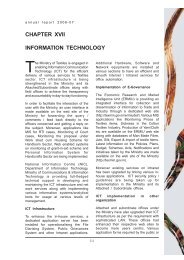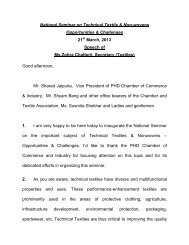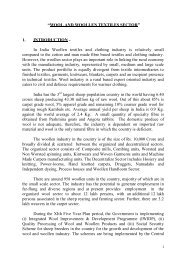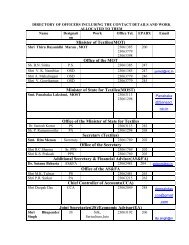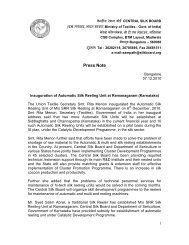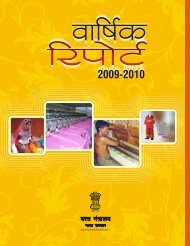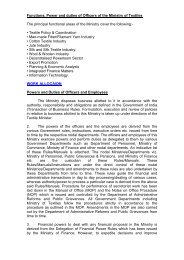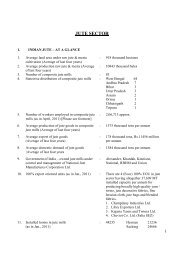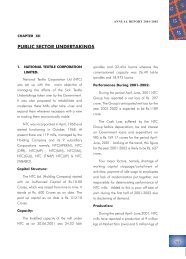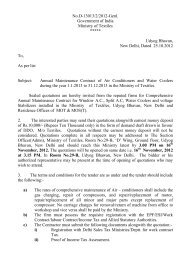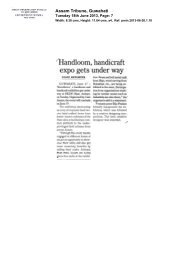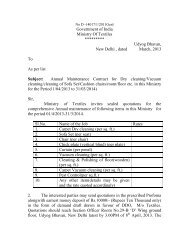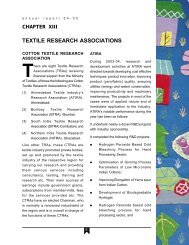cotton and man-made fibre filament yarn industry - Ministry of Textiles
cotton and man-made fibre filament yarn industry - Ministry of Textiles
cotton and man-made fibre filament yarn industry - Ministry of Textiles
You also want an ePaper? Increase the reach of your titles
YUMPU automatically turns print PDFs into web optimized ePapers that Google loves.
a n n u a l r e p o r t 0 4 - 0 5CHAPTER VICOTTON AND MAN-MADE FIBRE FILAMENTYARN INDUSTRYCOTTONCotton is one <strong>of</strong> the major cropscultivated in India. It accountsfor more than 75 % <strong>of</strong> the total<strong>fibre</strong> consumption in the spinning mills <strong>and</strong>56 % <strong>of</strong> the total <strong>fibre</strong> consumption in thetextile sector. The twin objectives <strong>of</strong>assuring <strong>of</strong>f-take <strong>of</strong> the farmers’ produceat remunerative prices <strong>and</strong> makingavailable adequate quantity <strong>of</strong> <strong>cotton</strong> at areasonable prices to the domestic textile<strong>industry</strong> are sought to be achieved throughtimely announcement <strong>of</strong> the MinimumSupport Price (MSP) to the farmers <strong>and</strong>through appropriate export – importintervention as <strong>and</strong> when necessary. It isthe endeavour <strong>of</strong> the Government toimprove the quality <strong>of</strong> <strong>cotton</strong> to that <strong>of</strong>international st<strong>and</strong>ards through effectiveimplementation <strong>of</strong> the Technology Missionon Cotton (TMC).PRODUCTIONANDCONSUMPTIONDuring the last five decades, theproduction <strong>of</strong> <strong>cotton</strong> increased from 30lakh bales <strong>of</strong> 170 kgs. each in 1950-51 toan all time high <strong>of</strong> 177.90 lakh bales (170Kg each) in 1996-97. There has also beena substantial rise in area under <strong>cotton</strong>cultivation from 58.91 lakh hectares in1950-51 to a record high <strong>of</strong> 92.87 lakhhectares in 1998-99. The average yieldhas risen from 88 kgs. in 1950-51 to 387kg. in 2003-04. For the <strong>cotton</strong> season2004-05 (Oct-Sept), the production <strong>of</strong><strong>cotton</strong> is estimated at a record high <strong>of</strong> 213lakh bales with an area <strong>of</strong> 89.69 lakhhectares <strong>and</strong> the average yield <strong>of</strong> 404 kgper hectare. One <strong>of</strong> the reasons for lowyield in India, as compared to worldaverage <strong>of</strong> about 680 kg/hectare, is that65% <strong>of</strong> the area under <strong>cotton</strong> cultivationis rainfed.The largest share in the total production<strong>of</strong> <strong>cotton</strong> is that <strong>of</strong> medium staple &medium long staple varieties followed bylong staple varieties. In 2003-04, the share<strong>of</strong> short staple <strong>cotton</strong> was about 4.5%, theshare <strong>of</strong> medium <strong>and</strong> medium long staplevarieties was 48.5 % <strong>and</strong> that <strong>of</strong> long <strong>and</strong>extra long staple varieties was 47 %. Themain <strong>cotton</strong> producing States areMaharashtra, Gujarat, Andhra Pradesh,Madhya Pradesh, Punjab, Haryana,Rajasthan, Karnataka <strong>and</strong> Tamil Nadu.Consumption <strong>of</strong> <strong>cotton</strong> has beenincreasing over the last few years. Asagainst a total consumption <strong>of</strong> 115.50lakh bales during 1990-91 (Mill <strong>and</strong> Non-Mill), the consumption level, includingconsumption by spinning units in thesmall scale sector <strong>and</strong> non-millconsumption, touched a record high <strong>of</strong>69
m i n i s t r y o f t e x t i l e s173.36 lakh bales in 1999-2000 <strong>cotton</strong>season. The domestic consumptionduring 2004-05 <strong>cotton</strong> season isestimated at a record high <strong>of</strong> 193 lakhbales. The variety-wise dem<strong>and</strong> for <strong>cotton</strong>almost follows the same pattern as thevariety-wise production. The majordem<strong>and</strong> is for medium <strong>and</strong> medium longstaple variety, which also has the largestshare in the total production <strong>of</strong> <strong>cotton</strong>.The dem<strong>and</strong> for short staple varieties isrelatively very small.Data on area, production, yield, <strong>and</strong>consumption <strong>of</strong> <strong>cotton</strong> from 1992-93 to2004-2005 is given at Table 6.1.PRICES OF COTTONThe Government announces the MinimumSupport Price (MSP) for different varieties<strong>of</strong> <strong>cotton</strong> every year to ensureremunerative prices for the <strong>cotton</strong>growers. The Cotton Corporation <strong>of</strong> India(CCI) is the agency for implementation <strong>of</strong>this policy in the country. The CCI entersthe market <strong>and</strong> makes purchases <strong>of</strong> <strong>cotton</strong>under support price operation wheneverprices touch the MSP level.The Government <strong>of</strong> India has fixed theSupport Price <strong>of</strong> two basic varieties <strong>of</strong><strong>cotton</strong>, viz. F-414/H 777/J-34 <strong>and</strong> H-4, <strong>of</strong>Fair Average Quality for the <strong>cotton</strong> season2004-05. The Support Price for kapas(seed <strong>cotton</strong>) <strong>of</strong> fair average quality for the<strong>cotton</strong> season 2004-05 (Oct-Sept) hasbeen fixed at Rs.1,760/- per quintal formedium staple variety (F-414/J-34/H-777),an increase <strong>of</strong> Rs.35/- per quintal over thesupport price <strong>of</strong> 2003-04. Similarly, thesupport price for H-4 (Long Staple) varietyhas been fixed at Rs.1,960/- per quintal,Table 6.1DATA ON AREA, PRODUCTION, YIELD AND CONSUMPTION OF COTTONCotton Area in Cotton Production Cotton Yield CottonYear Lakh in Lakh in 000’s in Kg/ ConsumptionHectares Bales <strong>of</strong> tonnes Hectare Lakh Bales <strong>of</strong>170 Kg. 170 Kg. EachMill + non Mill +small spinning1992-93 75.41 138.00 2,346.00 311 125.011993-94 74.40 121.50 2,065.00 278 127.001994-95 78.61 138.50 2,354.50 300 135.001995-96 90.63 170.70 2,901.90 320 154.291996-97 91.66 177.90 3,004.30 330 170.161997-98 88.29 158.00 2,686.00 307 159.011998-99 92.87 165.00 2,805.00 302 165.361999-2000 87.31 156.00 2,652.00 304 173.362000-2001 85.76 140.00 2,380.00 278 173.032001-2002 87.30 158.00 2,686.00 308 171.762002-2003 76.67 136.00 2,312.00 302 168.832003-04 77.85 177.00 3,009.00 387 173.252004-05 89.69 213.00 3,621.00 404 193.00(Prov.)Source: Cotton Advisory Board (CAB)70
a n n u a l r e p o r t 0 4 - 0 5an increase <strong>of</strong> Rs.35/- per quintal oversupport price <strong>of</strong> 2003-04. The MSP fixedfor F-414/H-777/J-34 variety <strong>of</strong> kapas isapplicable only to Rajasthan. For othervarieties, the Minimum Support Priceshave been announced by the TextileCommissioner based on quality <strong>and</strong>market price differentials.During 2004-05 <strong>cotton</strong> season, due tohigher global production, the prevailingkapas prices have been ruling lower thanthe prices during the corresponding periodlast year. Kapas prices have touched theMSP level in almost all the <strong>cotton</strong> growingstates <strong>and</strong> the CCI has undertaken MSPoperations. As on 08.03.2005, the CCI hasprocured 128.80 lakh quintal <strong>of</strong> kapas(equivalent to 25.04 lakh bales <strong>of</strong> lint<strong>cotton</strong>). This is an all time highprocurement by the CCI.In conformity with the liberalized economypolicy, both import <strong>and</strong> export <strong>of</strong> <strong>cotton</strong> isfree without any restrictions.COTTON ADVISORY BOARDThe Cotton Advisory Board (CAB) is arepresentative body <strong>of</strong> GovernmentAgencies, Growers, Industry & Trade. Itadvises the Government on matterspertaining to production, consumption <strong>and</strong>marketing <strong>of</strong> <strong>cotton</strong>, <strong>and</strong> also provides aforum for liaison among the <strong>cotton</strong> textile<strong>industry</strong>, the <strong>cotton</strong> growers, the <strong>cotton</strong>trade <strong>and</strong> the government. The Board wasreconstituted on 06.02.2004. It consists <strong>of</strong>56 members, <strong>and</strong> its reconstitution wassubsequently modified on 27.07.2004 <strong>and</strong>10.02.2005. At present it has 49 members,which includes 8 Central Governmentnominees, 11 State Governmentsrepresentative, 6 <strong>cotton</strong> growersrepresentative, 2 representatives <strong>of</strong> theTextile Industry, 5 representatives <strong>of</strong> theCotton Trade, 4 representatives <strong>of</strong> G&PSector, 3 representatives <strong>of</strong> CottonResearch & Development Institutions, 3representative <strong>of</strong> Powerloom Sector <strong>and</strong>1 representative <strong>of</strong> H<strong>and</strong>loom Sector. Thetenure <strong>of</strong> reconstituted Board is upto05.02.2006.INTERNATIONAL COTTONADVISORY COMMITTEE (ICAC)The International Cotton AdvisoryCommittee is an association <strong>of</strong>governments having an interest in theproduction, export, import <strong>and</strong>consumption <strong>of</strong> <strong>cotton</strong>. It is anorganisation designed to promotecooperation in the solution <strong>of</strong> <strong>cotton</strong>problems, particularly those <strong>of</strong>international scope <strong>and</strong> significance.The functions <strong>of</strong> the International CottonAdvisory Committee are :-●To observe <strong>and</strong> keep in close touchwith developments affecting theworld <strong>cotton</strong> situation;● To collect <strong>and</strong> disseminatecomplete, authentic, <strong>and</strong> timelystatistics on world <strong>cotton</strong> production,trade, consumption, stocks <strong>and</strong>prices;●To suggest to the governments anymeasures, which the Committeeconsiders suitable <strong>and</strong> practicablefor the furtherance <strong>of</strong> internationalcollaboration directed towards71
m i n i s t r y o f t e x t i l e s●developing <strong>and</strong> maintaining a soundworld <strong>cotton</strong> economy; <strong>and</strong>To be the forum <strong>of</strong> internationaldiscussions on matters related to<strong>cotton</strong> prices.For the fiscal year 2004 (July 2004-June2005), India’s contribution to ICAC is US$55,300 (approximately Rs. 25.50 lakh).The 63 rd Plenary Meeting <strong>of</strong> the ICACwas held in Mumbai, India from29.11.2004 to 03.12.2004 at the invitation<strong>of</strong> the <strong>Ministry</strong> <strong>of</strong> <strong>Textiles</strong>, Government <strong>of</strong>India. The Indian delegation was led byJoint Secretary, <strong>Ministry</strong> <strong>of</strong> <strong>Textiles</strong>. Thetheme <strong>of</strong> the meeting was “EnhancingCotton Competitiveness”.The next (64 th ) Plenary Meeting <strong>of</strong> theICAC will be held in UK in 2005.COTTON TECHNOLOGYMISSIONThe Government <strong>of</strong> India launched theTechnology Mission on Cotton (TMC) inFebruary 2000 to give a focussed impetusto <strong>cotton</strong> research <strong>and</strong> development. TheMission comprises four mini missions withspecific objectives <strong>of</strong> ‘research’,‘dissemination <strong>of</strong> technology to farmers’,‘improvement in market infrastructure’ <strong>and</strong>‘modernization <strong>of</strong> ginning <strong>and</strong> pressingsector’. The <strong>Ministry</strong> <strong>of</strong> <strong>Textiles</strong> isimplementing Mini Missions III & IV relatingto improvement in market infrastructure<strong>and</strong> modernization <strong>of</strong> Ginning & Pressingfactories.Upto February 2005, development <strong>of</strong> 112market yards <strong>and</strong> modernization <strong>of</strong> 447Ginning & Pressing Factories have beensanctioned at an estimated cost <strong>of</strong>Rs.781.23 crore out <strong>of</strong> which Government<strong>of</strong> India share would be Rs 200.29 crore.So far, 83 market yards have beencompleted <strong>and</strong> 289 ginning & pressingfactories have modernized.MAN-MADE FIBRE & FILAMENTYARN INDUSTRYThe <strong>man</strong>-<strong>made</strong> <strong>fibre</strong> & <strong>yarn</strong> <strong>industry</strong>comprises <strong>fibre</strong> <strong>and</strong> <strong>filament</strong> <strong>yarn</strong><strong>man</strong>ufacturing units <strong>of</strong> cellulosic <strong>and</strong> noncellulosicorigin. The cellulosic <strong>fibre</strong> /<strong>yarn</strong> <strong>industry</strong> is under the administrativecontrol <strong>of</strong> the <strong>Ministry</strong> <strong>of</strong> <strong>Textiles</strong> whilenon-cellulosic <strong>industry</strong> is under the control<strong>of</strong> <strong>Ministry</strong> <strong>of</strong> Chemicals & Fertilizers(Department <strong>of</strong> Chemicals & PetroChemicals).The production <strong>of</strong> <strong>man</strong>-<strong>made</strong> <strong>fibre</strong> duringApril-October, 2004 showed an increase<strong>of</strong> 15% as compared to the correspondingprevious period (April-October 2003). Thetotal <strong>man</strong>-<strong>made</strong> production is expected toincrease by about 11% during 2004-05 ascompared to the production in 2003-04.The production <strong>of</strong> viscose staple <strong>fibre</strong>,polyester staple <strong>fibre</strong>, acrylic staple <strong>fibre</strong><strong>and</strong> polypropylene staple <strong>fibre</strong> is expectedto increase by 10%, 11% <strong>and</strong> 9%respectively during 2004-05.The total production <strong>of</strong> <strong>man</strong>-<strong>made</strong><strong>filament</strong> <strong>yarn</strong> also increased by around7.52% during April-October, 2004 ascompared to the corresponding period <strong>of</strong>the previous year. However theproduction <strong>of</strong> polypropylene <strong>filament</strong> <strong>yarn</strong>72
a n n u a l r e p o r t 0 4 - 0 5declined by 21% during the period. Thetotal <strong>filament</strong> <strong>yarn</strong> production during2004-05 is expected to increase by about3% as compared to the production during2003-04. The production <strong>of</strong> nylon <strong>filament</strong><strong>yarn</strong> is expected to increase by about26% <strong>and</strong> polyester <strong>filament</strong> <strong>yarn</strong> isexpected to increase by 3% during 2004-05. However the production <strong>of</strong>polypropylene <strong>filament</strong> <strong>yarn</strong> is expectedto decline by about 22%.The production <strong>of</strong> nylon <strong>filament</strong> <strong>yarn</strong> isexpected to increase by about 26% <strong>and</strong>polyester dilament <strong>yarn</strong> is expected toincrease by 3% during 2004-05. Howeverthe production <strong>of</strong> polypropylene <strong>filament</strong><strong>yarn</strong> is expected to decline by about 22%<strong>and</strong> viscose <strong>filament</strong> <strong>yarn</strong> is expected todecline by about 1% during 2004-05. Theinstalled capacity <strong>and</strong> details <strong>of</strong> production<strong>of</strong> <strong>man</strong>-<strong>made</strong> <strong>fibre</strong> <strong>and</strong> <strong>filament</strong> <strong>yarn</strong> areat Table 6.2.IMPORTSThe import <strong>of</strong> <strong>man</strong>-<strong>made</strong> <strong>fibre</strong> / <strong>filament</strong><strong>yarn</strong> increased during the last five yearsbut the total import has declined by 25% during 2003-04 as compared to thecorresponding period <strong>of</strong> last year. Theimport <strong>of</strong> polyester <strong>filament</strong> <strong>yarn</strong>constituted about 73 % <strong>of</strong> the totalimports during 2003-04. The details <strong>of</strong>imports <strong>of</strong> <strong>man</strong>-<strong>made</strong> <strong>fibre</strong>s <strong>and</strong> <strong>yarn</strong>sare at Table 6.3 on page 63.Table 6.2INSTALLED CAPACITY AND PRODUCTION OF MAN-MADE FIBRE/FILAMENT YARN(In Mn Kg)Items: Type No. <strong>of</strong> Installed 2002- 2003- %age 2003- 2004- %ageunits capacity 2003 2004 <strong>of</strong> 2004 2005 <strong>of</strong>(tpa) 31/10/ growth (Apr- (Aprl- growth2004(p) Oct.) Oct.)(P)Viscose Staple Fibre ** 6 336.55 224.61 221.01 -1.60 118.52 142.52 20.16Polyester Staple Fibre 15 695.59 582.13 612.58 5.23 347.81 347.81 13.82Acrylic Staple Fibre 8 137.50 105.27 117.00 11.13 66.30 75.53 13.92Polypropylene 3 8.00 2.46 2.74 11.38 1.52 1.75 15.13Staple FibreTotal 32 1,177.64 914.47 953.33 4.25 534.15 615.57 15.24Viscose Filament Yarn 7 78.10 50.80 53.17 4.67 30.18 30.81 0.00Nylon Filament Yarn# 10 24.00 29.73 30.99 4.24 16.27 22.76 39.39Polyester Filament 41 1,172.25 995.37 1,013.00 1.77 564.79 607.82 7.02Yarn ##Polypropylene 13 17.38 24.41 20.82 -14.71 12.12 9.52 -21.45Filament Yarn#Total 71 1,291.73 1,100.31 1,117.98 1.61 623.99 670.91 7.52P = Provisional A = Anticipated* Including HWM <strong>fibre</strong>.** Grasim Industries at Mavoor, Kharach, Harihar & Nagda are treated as four units.#: The exclusive capacity <strong>of</strong> N.F.Y. <strong>and</strong> P.P.F.Y.##: The Capacity under Broad B<strong>and</strong>ing Scheme have been indicated against P.F.Y.73
m i n i s t r y o f t e x t i l e sEXPORTSThe Export <strong>of</strong> <strong>man</strong>-<strong>made</strong> <strong>fibre</strong> / <strong>filament</strong><strong>yarn</strong> showed a mixed trend during the lastfive years. The exports declined marginallyby about 4 % during 2003-04 as comparedto the previous year. Polyester staple <strong>fibre</strong><strong>and</strong> polyester <strong>filament</strong> <strong>yarn</strong> constitutedaround 73 % <strong>of</strong> total export <strong>of</strong> exports<strong>of</strong> <strong>man</strong>-<strong>made</strong> <strong>fibre</strong>s <strong>and</strong> <strong>yarn</strong>s during2003-04. The details are at Table 6.4.Table 6.3IMPORTS OF MAN-MADE FIBRE / FILAMENT YARN(In Tonnes)Years Viscose Polyester Acrylic Viscose Nylon Polyesterstaple staple staple <strong>filament</strong> <strong>filament</strong> <strong>filament</strong> Total<strong>fibre</strong> <strong>fibre</strong>/ <strong>fibre</strong> / <strong>yarn</strong> <strong>yarn</strong> <strong>yarn</strong>ddw/tops tow/tops1998-99 2,270 17,444 31,279 1,024 1,342 28,661 82,0201999-2000 975 13,830 14,374 842 2,979 75,248 1,08,2482000-01 1,168 21,309 14,066 500 3,641 57,644 98,3282001-02 1,717 26,947 9,669 1,592 3,710 80,955 1,24,5902002-03 2,712 25,812 21,719 6,780 3,356 1,10,830 1,71,2092003-03 2,672 12,057 12,754 3,429 3,290 93,837 1,28,039Source: Directorate General <strong>of</strong> Commercial Intelligence <strong>and</strong> Statistics (DGCIS), KolkataTable 6.4EXPORT OF MAN-MADE FIBRE / FILAMENT YARN(In Tonnes)Years Viscose Polyester Acrylic Viscose Nylon Polyesterstaple staple staple <strong>filament</strong> <strong>filament</strong> <strong>filament</strong> Total<strong>fibre</strong> <strong>fibre</strong>/ <strong>fibre</strong> / <strong>yarn</strong> <strong>yarn</strong> <strong>yarn</strong>ddw/tops tow/tops1998-99 914 16,587 438 5,005 1,556 36,699 61,1991999- 2000 1,597 51,065 728 7,851 1,464 49,182 1,11,8872000-2001 2,423 29,238 461 10,892 3,761 92,089 1,38,8642001-02 1,516 17,902 321 7,884 3,294 66,749 97,6662002-03 5,896 29,320 5,176 10,347 4,973 91,148 1,46,8602003-04 9,287 31,746 13,832 3,855 11,788 70,705 1,47,223Source: - Directorate General <strong>of</strong> Commercial Intelligence <strong>and</strong> statistics (DGCIS), Kolkata.74



